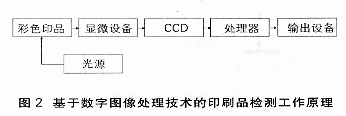On the one hand, the traditional print inspection system is a theory to describe the conversion characteristics of the printing process, and most of them are based on the color mixing model, such as the Neugebauer equations and the Murray-Davies formula. Related studies have revealed their inaccuracies and limitations. On the other hand, a detection method based on a densitometer or a colorimeter can only detect an area around 10mm2. Therefore, a special color patch (signal strip) must be printed on the printed sheet, and it cannot be completely obtained directly from the print screen. Required information. To overcome these deficiencies, digital image processing technology has been introduced into print inspection systems in recent years, and related products have entered the market.
The working principle based on digital image processing technology is shown in Figure 2. Since the human eye cannot see a single dot without the aid of the instrument, it can only see the entire appearance produced by the dot. In order to be able to distinguish the various dots, we must use a magnifying glass to observe. Charge Coupled Device (CCD) is called a Charge Coupled Device (CCD). It is a new type of semiconductor device for detecting the distribution of light intensity. It can be divided into a one-dimensional  line array or a two-dimensional  surface array 光电 photoelectric array. The use of an area array CCD as a sensor CCD camera is a new technology with a wide range of application prospects in modern testing technology. The signal obtained is a digital image after quantization, and a series of processing and conversion of the digital image are performed in the processor to finally obtain a series of parameters, such as density value, chroma value, and dot area rate. At the same time through the comparison with the standard proofs, but also detect print defects, such as color distortion, ink sticky, black spots, text blur, wrinkles, missing prints, scratches, overprint and so on.

5 Online Print Inspection Technology
In recent years, the printing industry has developed to small batches, varieties, and high-quality demand. Users have increasingly stringent requirements on product quality. Therefore, it is one of the means that the printing manufacturer carries out the automatic quality inspection of the printed matter during the printing process. It is not only the basis for the standardization of the printing quality data, but also the necessary link for the subsequent automatic printing control. Especially in high-speed printing presses, if you do not find and troubleshoot in time, it means that there is a large amount of waste defective goods. Therefore, the online quality inspection of printed materials has emerged. At present, there are manufacturers in Germany, Switzerland, the United States, Japan and other countries that can provide automatic print quality inspection equipment.
The working principle of online print inspection technology is shown in Figure 3. During the printing process, online inspections are carried out with the help of on-line testing equipment, and the information is sent to the center console in real time through the feedback loop, so that the corresponding printer components are automatically adjusted and online quality control of the printed matter is achieved. There is little manual intervention throughout the process.

In the online print detection technology, density, colorimetry and digital image processing techniques have all been used. For example, the first CPC image control system from Heidelberg, which uses spectrophotometric measurement technology to scan images, is an attempt to shift from simple planar density control to three-dimensional spectral color control. It uses dual detection of chromaticity and density and can be performed in less than 30 seconds. Complete the detection of a closed sheet and process the information on 160,000 measuring points on the printed sheet. After comparing with the standard data, the ink area information is displayed on the color touch screen. Unlike Heidelberg, Roland still insists on detecting the print quality and printing process through the density of printed ink. It does not follow the industry's monitoring and control methods of switching to spectroscopy. In addition, the BOBST in Switzerland, the PROIMACE in the United States, etc. adopt a method based on image processing technology. First, use high-definition, high-speed camera lens to take standard images, set a certain standard on the basis of this; then shoot the detected image, and then compare the two. The CCD linear sensor converts the change in the light quantity of each pixel into an electronic signal. After the comparison, if the detected image is different from the standard image, the system considers the detected image to be a defective product.
6 Outlook
With the high-tech penetration of the printing industry at a high speed, color printing presents a trend of digitization, automation, systematization, and diversification. We can foresee the future of printing quality standards will be further enhanced, thus promoting the detection of color prints toward the data , Standardization, standardization, automation direction. Let us focus more on the future and pay attention to the development of print quality inspection equipment and technology.
Source: "Printing World"
Author: Hu Tao Zheng Mindong Zhang Xiaohui